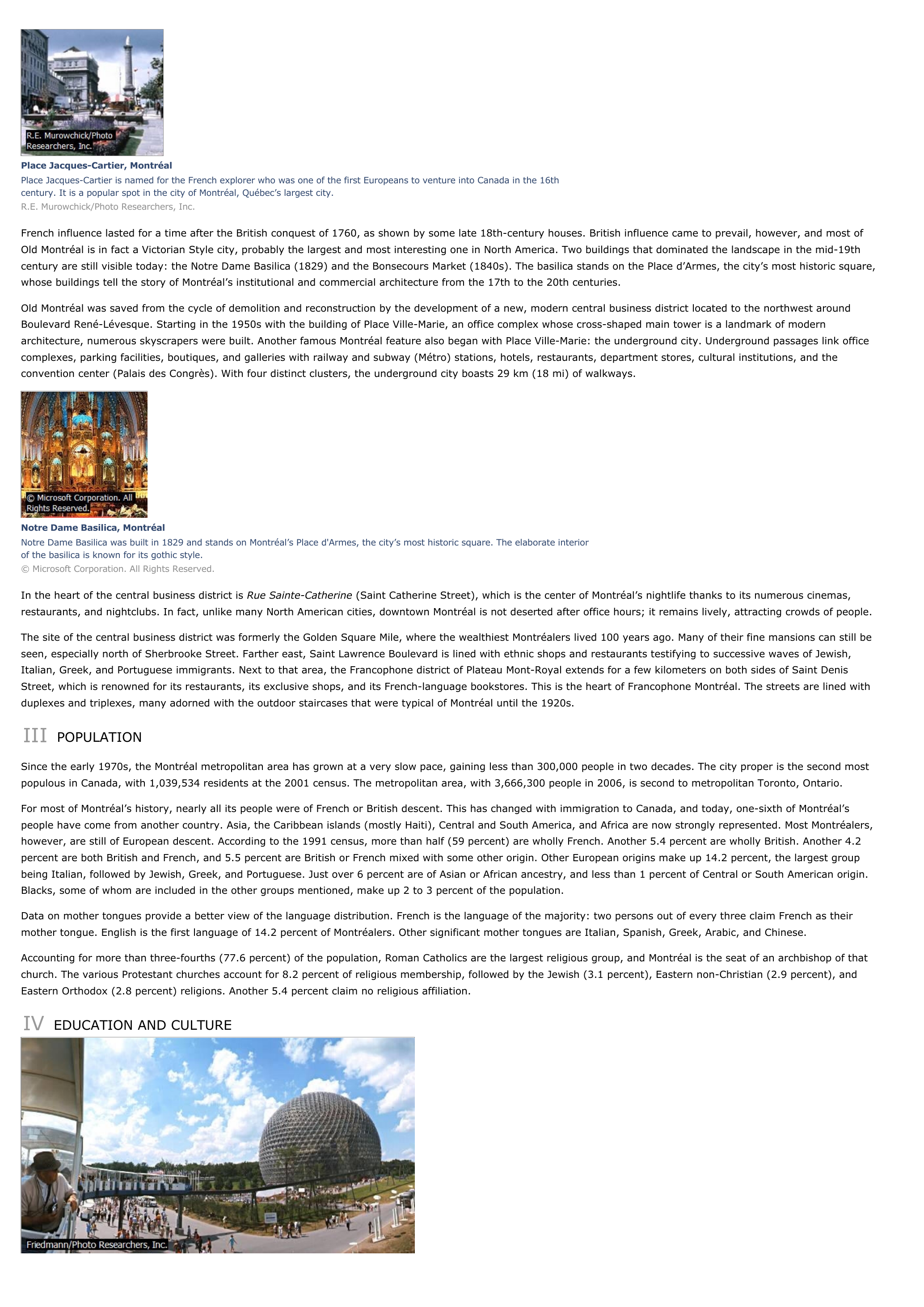Montréal - geography.
Publié le 26/05/2013

Extrait du document
«
Place Jacques-Cartier, MontréalPlace Jacques-Cartier is named for the French explorer who was one of the first Europeans to venture into Canada in the 16thcentury.
It is a popular spot in the city of Montréal, Québec’s largest city.R.E.
Murowchick/Photo Researchers, Inc.
French influence lasted for a time after the British conquest of 1760, as shown by some late 18th-century houses.
British influence came to prevail, however, and most ofOld Montréal is in fact a Victorian Style city, probably the largest and most interesting one in North America.
Two buildings that dominated the landscape in the mid-19thcentury are still visible today: the Notre Dame Basilica (1829) and the Bonsecours Market (1840s).
The basilica stands on the Place d’Armes, the city’s most historic square,whose buildings tell the story of Montréal’s institutional and commercial architecture from the 17th to the 20th centuries.
Old Montréal was saved from the cycle of demolition and reconstruction by the development of a new, modern central business district located to the northwest aroundBoulevard René-Lévesque.
Starting in the 1950s with the building of Place Ville-Marie, an office complex whose cross-shaped main tower is a landmark of modernarchitecture, numerous skyscrapers were built.
Another famous Montréal feature also began with Place Ville-Marie: the underground city.
Underground passages link officecomplexes, parking facilities, boutiques, and galleries with railway and subway (Métro) stations, hotels, restaurants, department stores, cultural institutions, and theconvention center (Palais des Congrès).
With four distinct clusters, the underground city boasts 29 km (18 mi) of walkways.
Notre Dame Basilica, MontréalNotre Dame Basilica was built in 1829 and stands on Montréal’s Place d'Armes, the city’s most historic square.
The elaborate interiorof the basilica is known for its gothic style.© Microsoft Corporation.
All Rights Reserved.
In the heart of the central business district is Rue Sainte-Catherine (Saint Catherine Street), which is the center of Montréal’s nightlife thanks to its numerous cinemas, restaurants, and nightclubs.
In fact, unlike many North American cities, downtown Montréal is not deserted after office hours; it remains lively, attracting crowds of people.
The site of the central business district was formerly the Golden Square Mile, where the wealthiest Montréalers lived 100 years ago.
Many of their fine mansions can still beseen, especially north of Sherbrooke Street.
Farther east, Saint Lawrence Boulevard is lined with ethnic shops and restaurants testifying to successive waves of Jewish,Italian, Greek, and Portuguese immigrants.
Next to that area, the Francophone district of Plateau Mont-Royal extends for a few kilometers on both sides of Saint DenisStreet, which is renowned for its restaurants, its exclusive shops, and its French-language bookstores.
This is the heart of Francophone Montréal.
The streets are lined withduplexes and triplexes, many adorned with the outdoor staircases that were typical of Montréal until the 1920s.
III POPULATION
Since the early 1970s, the Montréal metropolitan area has grown at a very slow pace, gaining less than 300,000 people in two decades.
The city proper is the second mostpopulous in Canada, with 1,039,534 residents at the 2001 census.
The metropolitan area, with 3,666,300 people in 2006, is second to metropolitan Toronto, Ontario.
For most of Montréal’s history, nearly all its people were of French or British descent.
This has changed with immigration to Canada, and today, one-sixth of Montréal’speople have come from another country.
Asia, the Caribbean islands (mostly Haiti), Central and South America, and Africa are now strongly represented.
Most Montréalers,however, are still of European descent.
According to the 1991 census, more than half (59 percent) are wholly French.
Another 5.4 percent are wholly British.
Another 4.2percent are both British and French, and 5.5 percent are British or French mixed with some other origin.
Other European origins make up 14.2 percent, the largest groupbeing Italian, followed by Jewish, Greek, and Portuguese.
Just over 6 percent are of Asian or African ancestry, and less than 1 percent of Central or South American origin.Blacks, some of whom are included in the other groups mentioned, make up 2 to 3 percent of the population.
Data on mother tongues provide a better view of the language distribution.
French is the language of the majority: two persons out of every three claim French as theirmother tongue.
English is the first language of 14.2 percent of Montréalers.
Other significant mother tongues are Italian, Spanish, Greek, Arabic, and Chinese.
Accounting for more than three-fourths (77.6 percent) of the population, Roman Catholics are the largest religious group, and Montréal is the seat of an archbishop of thatchurch.
The various Protestant churches account for 8.2 percent of religious membership, followed by the Jewish (3.1 percent), Eastern non-Christian (2.9 percent), andEastern Orthodox (2.8 percent) religions.
Another 5.4 percent claim no religious affiliation.
IV EDUCATION AND CULTURE.
»
↓↓↓ APERÇU DU DOCUMENT ↓↓↓
Liens utiles
- Montréal - geography.
- Montréal - Geography.
- Montréal - geography.
- Tremblay Michel, né en 1942 à Montréal, écrivain canadien d'expression française.
- Riopelle Jean-Paul, né en 1923 à Montréal, peintre canadien.

































